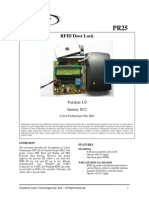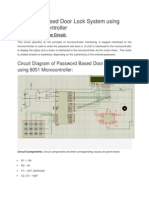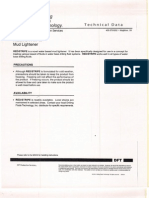10 Operatn
10 Operatn
Uploaded by
Srikar BukkapatnamCopyright:
Available Formats
10 Operatn
10 Operatn
Uploaded by
Srikar BukkapatnamCopyright
Available Formats
Share this document
Did you find this document useful?
Is this content inappropriate?
Copyright:
Available Formats
10 Operatn
10 Operatn
Uploaded by
Srikar BukkapatnamCopyright:
Available Formats
RFID BASED AUTOMOBILE SECURITY SYSTEM
Circuit Operation
5.1 Introduction:
The total hardware and software description are discussed above which are more helpful to understand the circuit operation. The circuit operation and utilization of the microcontroller and also the interface connected as shown in Fig 5.1.1. The practical and real time application circuits are explained with internal blocks of an automobile mainly the starter solenoid of automobiles.
Figure 5.1.1 Block Diagram of Automobile Security System
4.2
Flow Charts and algorithm
Algorithm:
Step 1: Power ON the supply 230v Step 2: Press the reset button once Step 3: LCD o/p message will be WELCOME TO RFID SECURITY SYSTEM Step 4: Keep the respective tag towards the RFID reader Step 5: If the tag code matches, Step 6: LCD o/p display ACCESS GRANTED Step 7: Relay/solenoid gets activated according to the system operation Step 8: If the tag code doesnt matches, Step 9: LCD displays as ACCESS DENIED ID Step 10: Recheck the tag and try once again from step 4 after few seconds
DEPT OF ELECTRONICS AND COMMUNICATION ENGINEERING
Page 38
RFID BASED AUTOMOBILE SECURITY SYSTEM
Flow Chart:
START
ON THE POWER SUPPLY Press the reset button Display: welcome to RFID Security
Keep the card towards the reader
Re check the Tag ones
If tag ID Matches
NO
Display: Access denied ID
YES
Display: Access granted
Relay/Soleno id ONs with a beep
Figure 4.3.2 Total operation of the circuit
DEPT OF ELECTRONICS AND COMMUNICATION ENGINEERING
Page 39
RFID BASED AUTOMOBILE SECURITY SYSTEM
5.2 Connections:
RFID Automobile Security System to derive the power supply, the 230V, 50Hz AC mains is stepped down by transformer X1 to deliver a secondary output of 15V, 500mA. The transformer output is rectified by a full-wave rectifier comprising diodes D1 through D4, filtered by capacitor C1 and regulated by ICs 7812 (IC2) and 7805 (IC3). Capacitor C2 bypasses the ripples present in the regulated supply. LED1 acts as the power indicator and R2 limits the current through LED1. The compact circuitry is built around Atmel AT89S52 microcontroller. The system clock also plays a significant role in operation of the microcontroller. An 11.0592MHz quartz crystal connected to pins 18 and 19 provides basic clock to the microcontroller. Power-on reset is provided by the combination of electrolytic capacitor C4 and resistor R1. Switch S1 is used for manual reset. Port pins P2.0 through P2.7 of the microcontroller are connected to data port pins D0 through D7 of the LCD, respectively. Port pins P3.7 and P3.6 of the microcontroller are connected to register-select (RS) and enable (E) pins of the LCD, respectively. Read/write (R/W) pin of the LCD is grounded to enable for write operation. Resistor R6 limits the current through the backlight of the LCD. Port pins P3.0 (RXD) and P3.1 (TXD) of the microcontroller are used to interface with the RFID reader. When power is removed the reverse voltage spike [back EMF produced by the relay due to magnetic field discharge] is observed by the diode connected parallel to the relay.
Figure 5.2.1 Circuit diagram of the Practical system
5.3 Operation:
DEPT OF ELECTRONICS AND COMMUNICATION ENGINEERING
Page 38
RFID BASED AUTOMOBILE SECURITY SYSTEM
CASE 1: When an authorized person having the tag enters the RF field generated by the RFID reader, RF signal is generated by the RFID reader to transmit energy to the tag and retrieve data from the tag. Then the RFID reader communicates through RXD and TXD pins of the microcontroller for further processing. Thus on identifying the authorized person, port pin P3.2 goes high, transistor T2 drives into saturation, provides ground to the relay and relay RL1 energizes and activates. Simultaneously, the LCD shows access granted ID message and port pin P1.7 drives piezo buzzer PZ1 via transistor T1 for aural indication. CASE 2:If the person is unauthorized, the LCD shows access denied ID and the relay doesnt operate. So the circuit will not operates because the code of the RFID will not match with the code embedded in the program of micro controller, there will be no activation signal for T1 and T2
5.4 Practical Implementation:
The power RPS is replaced with the battery of the automobile and in the place of Relay we take 12v solenoid of any automobile. According to the figure our 12v input is given to the s terminal and ground to the T2 transistor of the circuit Battery connection is taken from the battery and given to the battery terminal and the starter connection is given to the starter terminal of the solenoid component which is a part of the starter motor.
Figure 5.4.1 Real time application of the system
The circuit operates in the same way as it is operated when theres a relay It continues with the same two conditions the operation of the solenoid in the starter solenoid is explained here When ignition key is pressed to the start position 12v signal will get to the ignition switch
Page 39
DEPT OF ELECTRONICS AND COMMUNICATION ENGINEERING
RFID BASED AUTOMOBILE SECURITY SYSTEM
Current from the s terminal reaches the ground through the winding of the solenoid A magnetic field is created around that wire, this magnetic field den pushes the plunger which also pushes the contact washer then makes the contact with the battery and the starter within the solenoid
Figure 5.4.2 Practical solenoid working
Solenoid makes a high ampere current connection from the battery to starter[solenoid is controlled by the low voltage signal(12v) ] The starter solenoid receives a large electric current from the automobile battery and a small electric current from the ignition switch [supply from the designed circuit]. When the ignition switch is turned on, a small electric current is sent to the starter solenoid. This causes the starter solenoid to close a pair of heavy contacts, thus relaying a large electric current to the starter motor, which in turn sets the engine in motion.
Our circuit acts as a ignition signal given to the solenoid switch which exists the connection between battery to the starter. Starter solenoid is the main component used in this project which is used to activates the vehicle and its total housing is shown in the figure 5.4.2
DEPT OF ELECTRONICS AND COMMUNICATION ENGINEERING
Page 38
RFID BASED AUTOMOBILE SECURITY SYSTEM
Figure 5.4.3 Starter solenoid of the regular automobile
1. Main Housing (yoke) 3. Armature 5. Brushes
2. Overrunning clutch 4. Field coils 6. Solenoid
5.5 Summary
The main circuit operation is totally explained and main defaults of the circuit are Circuit should be developed for high currents. Programming should be developed so that the relay(solenoid) operates for some more time to produce a connection between battery and starter so that vehicle gets started
DEPT OF ELECTRONICS AND COMMUNICATION ENGINEERING
Page 38
You might also like
- Isomerism of Chromium (III) Complexes (Inorganic Chem Laboratory Experiment)Document7 pagesIsomerism of Chromium (III) Complexes (Inorganic Chem Laboratory Experiment)Alyssa Kriel57% (7)
- Power of PsalmsDocument3 pagesPower of Psalmsએટનાડ ઓડિલોન50% (2)
- Project Report Speed Control of Induction MotorDocument47 pagesProject Report Speed Control of Induction Motorsrajaprojects0% (1)
- Fortune - No One Has StarvedDocument6 pagesFortune - No One Has StarvedSamson FungNo ratings yet
- University Malaya: ChemEcar CompetitionDocument6 pagesUniversity Malaya: ChemEcar CompetitionJoeNo ratings yet
- Rfid Based Security System With Password & Door MechanismDocument77 pagesRfid Based Security System With Password & Door MechanismVipul GargNo ratings yet
- DocumentDocument66 pagesDocumentManasa KilaruNo ratings yet
- In Industrial Process, Speed As A Variable Refers To The ReDocument71 pagesIn Industrial Process, Speed As A Variable Refers To The Reapi-19786583No ratings yet
- Main Project AbstractDocument6 pagesMain Project AbstractKeerthi KeethuNo ratings yet
- Vehicle Locking Iot-1Document57 pagesVehicle Locking Iot-120.009.KIRUTHICKROSHAN T. MECH.No ratings yet
- Highway Speed CheckerDocument24 pagesHighway Speed Checkerritesh chauhanNo ratings yet
- Monitoring and Control of Single Phase Induction Motor: Power SupplyDocument16 pagesMonitoring and Control of Single Phase Induction Motor: Power SupplydineshkumarNo ratings yet
- Major Report On Automatic Car Parking: Chapter-I 1.1 About ProjectDocument39 pagesMajor Report On Automatic Car Parking: Chapter-I 1.1 About ProjectAkansha Johri RajputNo ratings yet
- Team 4 Technical ReportDocument12 pagesTeam 4 Technical Reportabdelrahmanmoataz0No ratings yet
- Cell Phone Based DTMF Controlled Garage Door Opening SystemDocument33 pagesCell Phone Based DTMF Controlled Garage Door Opening SystemAntaripaBhuyanNo ratings yet
- WK 214modDocument90 pagesWK 214modadusumilliabhishekNo ratings yet
- 1Document15 pages1REDDYGAARI ABBAYINo ratings yet
- "Speed Control of DC Motor by Using PWM": IjarcceDocument3 pages"Speed Control of DC Motor by Using PWM": IjarcceRishi GaddaNo ratings yet
- Atm Security PsyDocument84 pagesAtm Security Psyarunraja98No ratings yet
- Qa-00447 - Vehicle Accident Prevention Using Eye Blink SensorDocument15 pagesQa-00447 - Vehicle Accident Prevention Using Eye Blink Sensorvasanth sparkNo ratings yet
- Important Report File Electricity Theft...Document32 pagesImportant Report File Electricity Theft...Jatinder SainiNo ratings yet
- Microcontroller Based Vehicle Security SystemDocument67 pagesMicrocontroller Based Vehicle Security Systemlokesh_045No ratings yet
- Vehicle Speed Control System Using RF CommunicationDocument80 pagesVehicle Speed Control System Using RF CommunicationSaheb Amrinder100% (6)
- 2.password Based Door Lock System Using 8051 MicrocontrollerDocument4 pages2.password Based Door Lock System Using 8051 MicrocontrolleranupamdubeyNo ratings yet
- Wireless Energy Meter Reading Using RF TechnologyDocument26 pagesWireless Energy Meter Reading Using RF Technologyaditiaser100% (1)
- Doc of Automatic Load Sharing of TransformersDocument136 pagesDoc of Automatic Load Sharing of TransformersVeda Komakula56% (9)
- Design and Implementation of Digital Trigger Circuit For ConverterDocument6 pagesDesign and Implementation of Digital Trigger Circuit For ConverterBilal Ali AhmadNo ratings yet
- ElectricityDocument21 pagesElectricityChinmay JagadaleNo ratings yet
- Design: IdeasDocument6 pagesDesign: IdeasSamantha EwingNo ratings yet
- RFID Door Lock: January 2012Document13 pagesRFID Door Lock: January 2012AnasSyakirAzmiNo ratings yet
- PNEUmatic Crane NewDocument26 pagesPNEUmatic Crane NewVignesh VaranNo ratings yet
- Project Introductive Seminar OnDocument26 pagesProject Introductive Seminar OnDarshanNo ratings yet
- Micro Controller Based Traffic Light Controller: Er. Sunimerjit KaurDocument26 pagesMicro Controller Based Traffic Light Controller: Er. Sunimerjit KaurRahul Sharma100% (1)
- 3.automated Transformer Coil Winding MachineDocument31 pages3.automated Transformer Coil Winding Machinecelphone533No ratings yet
- Fake Currency Tester and Counter Project ReportDocument44 pagesFake Currency Tester and Counter Project ReportGagan Maggo100% (2)
- Automatic Car ParkingDocument41 pagesAutomatic Car Parkingash43black78% (18)
- Applications of MicrocontrollerDocument12 pagesApplications of MicrocontrollerBabak DanyalNo ratings yet
- Simulation and Design of A Waveform Generator Based On DDS TechnologyDocument7 pagesSimulation and Design of A Waveform Generator Based On DDS TechnologyMounith HNo ratings yet
- Simulation and Design of A Waveform Generator Based On DDS TechnologyDocument7 pagesSimulation and Design of A Waveform Generator Based On DDS TechnologyMounith HNo ratings yet
- Intelligent Train Engine: PROJECT WORK 2009-2010Document41 pagesIntelligent Train Engine: PROJECT WORK 2009-2010Naresh9535714401No ratings yet
- Microcontroll Er Based Car Parking SystemDocument46 pagesMicrocontroll Er Based Car Parking SystemEr Amit BhattNo ratings yet
- Temp Measurment Using GSMDocument12 pagesTemp Measurment Using GSMRavi JoshiNo ratings yet
- Traffic Light Control SystemDocument12 pagesTraffic Light Control SystemVinay ReddyNo ratings yet
- Numerical RelayDocument8 pagesNumerical RelayDilip KumarNo ratings yet
- Microprocessor Based Impedance Relay: TechnicalsymposiumDocument14 pagesMicroprocessor Based Impedance Relay: TechnicalsymposiumGaurav JaiswalNo ratings yet
- Bluetooth Based Home AutomationDocument15 pagesBluetooth Based Home AutomationSiddharth DevNo ratings yet
- FinalDocument33 pagesFinalnaveenaNo ratings yet
- Moving MessageDocument61 pagesMoving MessagekhasimNo ratings yet
- Handheld Vehicle Lock Control System Using Wireless Communication (IR RF)Document3 pagesHandheld Vehicle Lock Control System Using Wireless Communication (IR RF)Sreekanth PagadapalliNo ratings yet
- Wireless Energy Transmitter With Tariff SystemDocument61 pagesWireless Energy Transmitter With Tariff SystemBattu ChandrahasNo ratings yet
- rc5 BasicsDocument41 pagesrc5 BasicsFaraz AliNo ratings yet
- A Project Report ON Wireless Speed Control of Fan Using IrDocument69 pagesA Project Report ON Wireless Speed Control of Fan Using IrSomeswararao MuppanaNo ratings yet
- Automatic Railway GateDocument63 pagesAutomatic Railway GateRohit KumarNo ratings yet
- Mobile Phone Charger ReportDocument16 pagesMobile Phone Charger ReportVarun Khanna100% (3)
- A Remote Electricity Billing SystemDocument9 pagesA Remote Electricity Billing SystemHemant PatelNo ratings yet
- LGEC002 Door Lock System Using RFDocument8 pagesLGEC002 Door Lock System Using RFShivani MehrotraNo ratings yet
- Saini Science Projects Mob. 9255747495: MajorDocument4 pagesSaini Science Projects Mob. 9255747495: MajorVinod KumarNo ratings yet
- 582 - Password Based Door Lock System Using 8051 MicrocontrollerDocument3 pages582 - Password Based Door Lock System Using 8051 MicrocontrollerDaniel Kassaw100% (2)
- Reference Guide To Useful Electronic Circuits And Circuit Design Techniques - Part 2From EverandReference Guide To Useful Electronic Circuits And Circuit Design Techniques - Part 2No ratings yet
- Reference Guide To Useful Electronic Circuits And Circuit Design Techniques - Part 1From EverandReference Guide To Useful Electronic Circuits And Circuit Design Techniques - Part 1Rating: 2.5 out of 5 stars2.5/5 (3)
- Aspen Flowsheet For Cumene ProductionDocument10 pagesAspen Flowsheet For Cumene ProductionSaurabh SaraffNo ratings yet
- ODF Myanmar Flood-Resilient School Proposal (Eng)Document5 pagesODF Myanmar Flood-Resilient School Proposal (Eng)Nyein Chan HtweNo ratings yet
- AC 2 Philips FoodDocument2 pagesAC 2 Philips Foodbikramjit kunduNo ratings yet
- Safety Data Sheet: 1. Identification of The Substance/Preparation and of The Company/UndertakingDocument7 pagesSafety Data Sheet: 1. Identification of The Substance/Preparation and of The Company/Undertakingafifatul jannahNo ratings yet
- Phaeophyta (Brown Algae)Document22 pagesPhaeophyta (Brown Algae)Sona PectusNo ratings yet
- Triblender Wet Savoury F3218Document32 pagesTriblender Wet Savoury F3218danielagomezga_45545100% (1)
- Extreme Power in A Compact DesignDocument5 pagesExtreme Power in A Compact Design9867989055No ratings yet
- Chapter 2 - Incident Response, Business Continuity and Disaster Recovery ConceptsDocument12 pagesChapter 2 - Incident Response, Business Continuity and Disaster Recovery ConceptsgabrielgngrNo ratings yet
- EOR MethodsDocument16 pagesEOR MethodsPankaj KumarNo ratings yet
- X'Gfokku: Iz'Uif DKDocument22 pagesX'Gfokku: Iz'Uif DKRavikanthNo ratings yet
- PR 2 GroupDocument33 pagesPR 2 GroupElaine DeriloNo ratings yet
- Pharmacy Setting of Other ASEAN CountriesDocument9 pagesPharmacy Setting of Other ASEAN CountriesKathe MechureNo ratings yet
- Red Stripe Mud LightnerDocument6 pagesRed Stripe Mud LightnerChris SniderNo ratings yet
- # Sex Education in Islam...Document13 pages# Sex Education in Islam...MuinNo ratings yet
- Journal of Orthopaedic Surgery and ResearchDocument6 pagesJournal of Orthopaedic Surgery and ResearchDewye SartikaNo ratings yet
- Overview of ProfessionalNursing Practice-1Document16 pagesOverview of ProfessionalNursing Practice-1Rommel Marcos Jr.No ratings yet
- Cell Freeze Storage Containers: The Next Generation in Freezing Bags For Cryogenic StorageDocument2 pagesCell Freeze Storage Containers: The Next Generation in Freezing Bags For Cryogenic StorageCampaign MediaNo ratings yet
- Outlines of Lessons in Botany, Part I From Seed To Leaf by Newell, Jane H.Document66 pagesOutlines of Lessons in Botany, Part I From Seed To Leaf by Newell, Jane H.Gutenberg.orgNo ratings yet
- CCrew SecretsDocument0 pagesCCrew SecretsCristina Alexandra100% (1)
- FilariaDocument13 pagesFilariaKrishna Gowri DasariNo ratings yet
- Ecological Systems Theory FINALDocument13 pagesEcological Systems Theory FINALAbbie Faye E. Lee100% (1)
- How Much-How Many - Countables and UncountablesDocument4 pagesHow Much-How Many - Countables and UncountablesSunny HerreraNo ratings yet
- Individual PsychologyDocument16 pagesIndividual PsychologyCris Jean JasonNo ratings yet
- Hydraulic Cylinder TroubleshootingDocument8 pagesHydraulic Cylinder Troubleshootingcristi_ama100% (1)
- PRACTICE TEST 2 KeyDocument15 pagesPRACTICE TEST 2 KeyYến MaiNo ratings yet
- MSVI Term ReportDocument7 pagesMSVI Term ReportDanial ShadNo ratings yet

























































































